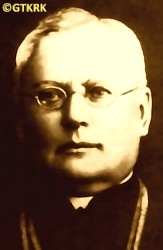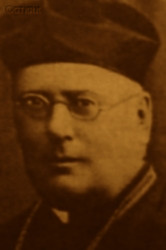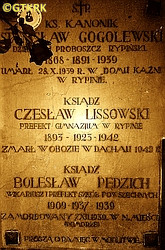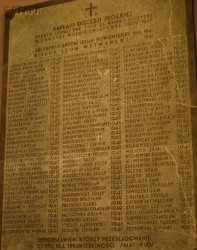Roman Catholic
St Sigismund parish
05-507 Słomczyn
85 Wiślana Str.
Konstancin deanery
Warsaw archdiocese, Poland
full list:
displayClick to display full list

searchClick to search full list by categories
wyświetlKliknij by wyświetlić pełną listę po polsku

szukajKliknij by przeszukać listę wg kategorii po polsku

Martyrology of the clergy — Poland
XX century (1914 – 1989)
personal data
surname
GOGOLEWSKI
forename(s)
Stanislav (pl. Stanisław)
function
diocesan priest
creed
Latin (Roman Catholic) Church RCmore on
en.wikipedia.org
[access: 2014.09.21]
diocese / province
Płock diocesemore on
en.wikipedia.org
[access: 2013.05.19]
honorary titles
honorary canonmore on
en.wikipedia.org
[access: 2014.11.14]
(Annunciation to the Blessed Virgin Mary RC collegiate church, Pułtusktoday: Pułtusk gm., Pułtusk pov., Masovia voiv., Poland
more on
en.wikipedia.org
[access: 2021.12.18])
honorary canonmore on
en.wikipedia.org
[access: 2014.11.14]
(Annunciation to the Blessed Virgin Mary RC collegiate church, Pułtusktoday: Pułtusk gm., Pułtusk pov., Masovia voiv., Poland
more on
en.wikipedia.org
[access: 2021.12.18], Assumption of the Blessed Virgin Mary RC cathedral church, Płocktoday: Płock city pov., Masovia voiv., Poland
more on
en.wikipedia.org
[access: 2021.12.18])
date and place
of death
28.10.1939

Rypintoday: Rypin gm., Rypin pov., Kuyavia‐Pomerania voiv., Poland
more on
en.wikipedia.org
[access: 2021.12.18]
details of death
For collecting money for church construction without permission interned in c. 1900 by the Russian Tsarist authorities in Obory monastery, where Russians sent Polish priests regarded as incorrigible and defiant, for a fortnight.
In 1920, during the Polish–Russian war of 1919‐1921, a founding member of the Citizens' Committee for State Defense for the Rypin County (established on 11.07.1920, during the Russian offensive against Poland, which ended with the Polish triumph in the Battle of Warsaw, known as the „Miracle on the Vistula”, in 08.1920).
After German and Russian invasions of Poland in 09.1939 and start of the World War II, after start of German occupation, arrested by the Germans on 20.10.1939.
Led to VSH Rypin jail in Rypin.
There murdered after repeated interrogations, usually lasting whole night, beating with a whip and tortures (among others with Fr Vladislav Gajewski) — lost consciousness during morning prison walk and perished.
cause of death
murder
perpetrators
Germans
sites and events
VSH RypinClick to display the description, «Intelligenzaktion»Click to display the description, Reichsgau Danzig‐WestpreußenClick to display the description, Ribbentrop‐MolotovClick to display the description, Pius XI's encyclicalsClick to display the description, Polish‐Russian war of 1919‐1921Click to display the description
date and place
of birth
20.05.1868Birth certification on:
www.genealogiawarchiwach.pl
[access: 2025.09.08]

Ciechocinektoday: Ciechocinek gm., Aleksandrów Kujawski pov., Kuyavia‐Pomerania voiv., Poland
more on
en.wikipedia.org
[access: 2020.12.16]
alt. dates and places
of birth
08.05.1868
(Julian calendar)
parents
GOGOLEWSKI Romualdo
🞲 ?, ? — 🕆 ?, ?

ALECHNIEWICZ Helen
🞲 ?, ? — 🕆 ?, ?
baptism
13.06.1868Birth certification on:
www.genealogiawarchiwach.pl
[access: 2025.09.08]

Raciążektoday: Raciążek gm., Aleksandrów Kujawski pov., Kuyavia‐Pomerania voiv., Poland
more on
en.wikipedia.org
[access: 2021.12.18]
All the Saints and St Jerome the Confessor and Doctor of the Church RC church
presbyter (holy orders)
ordination
1890

positions held
1911 – 1939
dean — Rypintoday: Rypin gm., Rypin pov., Kuyavia‐Pomerania voiv., Poland
more on
en.wikipedia.org
[access: 2021.12.18] RC deanery
1911 – 1939
parish priest — Rypintoday: Rypin gm., Rypin pov., Kuyavia‐Pomerania voiv., Poland
more on
en.wikipedia.org
[access: 2021.12.18] ⋄ Holy Trinity RC parish ⋄ Rypintoday: Rypin gm., Rypin pov., Kuyavia‐Pomerania voiv., Poland
more on
en.wikipedia.org
[access: 2021.12.18] RC deanery
1901 – 1911
parish priest — Sadłowotoday: Rypin gm., Rypin pov., Masovia voiv., Poland
more on
en.wikipedia.org
[access: 2021.12.18] ⋄ St John the Baptist RC parish ⋄ Rypintoday: Rypin gm., Rypin pov., Kuyavia‐Pomerania voiv., Poland
more on
en.wikipedia.org
[access: 2021.12.18] RC deanery
1899 – 1901
curatus/rector/expositus — Gójsktoday: Szczutkowo gm., Sierpc pov., Masovia voiv., Poland
more on
en.wikipedia.org
[access: 2021.12.18] ⋄ St Nicholas the Bishop and Confessor RC church ⋄ Szczutowotoday: Szczutowo gm., Sierpc pov., Masovia voiv., Poland
more on
en.wikipedia.org
[access: 2021.12.18], St Mary Magdalene RC parish ⋄ Sierpctoday: Sierpc urban gm., Sierpc pov., Masovia voiv., Poland
more on
en.wikipedia.org
[access: 2021.12.18] RC deanery
1898 – 1899
administrator — Pawłowo Kościelnetoday: Czernice Borowe gm., Przasnysz pov., Masovia voiv., Poland
more on
en.wikipedia.org
[access: 2021.12.18] ⋄ Blessed Virgin Mary and St Anthony of Padua RC church ⋄ St Matthias the Apostle RC parish ⋄ Przasnysztoday: Przasnysz urban gm., Przasnysz pov., Masovia voiv., Poland
more on
en.wikipedia.org
[access: 2021.12.18] RC deanery
1894 – 1898
vicar — Rzekuńtoday: Rzekuń gm., Ostrołęka pov., Masovia voiv., Poland
more on
en.wikipedia.org
[access: 2021.08.06] ⋄ Sacred Heart of Jesus RC parish ⋄ Ostrołękatoday: Ostrołęka city pov., Masovia voiv., Poland
more on
en.wikipedia.org
[access: 2021.08.06] RC deanery
1892 – 1894
vicar — Czerwińsk nad Wisłątoday: Czerwińsk nad Wisłą gm., Płońsk pov., Masovia voiv., Poland
more on
en.wikipedia.org
[access: 2021.09.02] ⋄ Annunciation to the Blessed Virgin Mary RC parish ⋄ Płońsktoday: Płońsk urban gm., Płońsk pov., Masovia voiv., Poland
more on
en.wikipedia.org
[access: 2021.12.18] RC deanery
1891 – 1892
vicar — Karniewotoday: Karniewo gm., Maków Mazowiecki pov., Masovia voiv., Poland
more on
en.wikipedia.org
[access: 2021.12.18] ⋄ Sacred Heart of Jesus RC church ⋄ All the Saints RC parish ⋄ Maków Mazowieckitoday: Maków Mazowiecki urban gm., Maków Mazowiecki pov., Masovia voiv., Poland
more on
en.wikipedia.org
[access: 2021.08.06] RC deanery
1890 – 1891
vicar — Rosochate Kościelnetoday: Czyżew gm., Wysokie Mazowieckie pov., Podlaskie voiv., Poland
more on
en.wikipedia.org
[access: 2021.12.18] ⋄ St Dorothy Virgin and Martyr RC parish ⋄ Ostrów Mazowieckatoday: Ostrów Mazowiecka gm., Ostrów Mazowiecka pov., Masovia voiv., Poland
more on
en.wikipedia.org
[access: 2021.12.18] RC deanery
1885 – 1890
student — Płocktoday: Płock city pov., Masovia voiv., Poland
more on
en.wikipedia.org
[access: 2021.12.18] ⋄ philosophy and theology, Theological Seminary
others related
in death
GAJEWSKIClick to display biography Vladislav, BATKOClick to display biography Alexander, BORZYSZKOWSKIClick to display biography Joseph, BUSZTAClick to display biography Anthony (Fr Simon), FLACZYŃSKIClick to display biography Francis, GRABOWSKIClick to display biography Sigismund, HINZClick to display biography Thaddeus, JARANOWSKIClick to display biography Constantine Stanislav, KACZOROWSKIClick to display biography Michael, MAKOWSKIClick to display biography Paul (Fr Bruno), MALINOWSKIClick to display biography Constantine Peter, MATEUSZCZYKClick to display biography Theodore, NOWAKClick to display biography Stanislav Zeno, OSTROWSKIClick to display biography Francis Xavier, PĘDZICHClick to display biography Boleslav, PRABUCKIClick to display biography Boleslav Rock, PRYBAClick to display biography Leo Simon, RADTKEClick to display biography Steven Boleslav, SŁAWIŃSKIClick to display biography Stanislav, WALCZAKClick to display biography Mary (Sr Theodosia), WILAMOWSKIClick to display biography Alexander, ŻUCHOWSKIClick to display biography Vaclav
sites and events
descriptions
VSH Rypin: German Germ. Volksdeutscher Selbstschutzhaft (Eng. Volksdeutscher Selbstschutz custody) VSH for the inhabitants of the Dobrzyń region founded in 09/10.1939 by Germans, members of the genocidal paramilitary Germ. Volksdeutscher Selbstschutz formation — the decision to create Selbstschutz in the Polish lands occupied by German troops was made in Berlin on 08‐10.09.1939 at a conference headed by Reichsführer‐SS Heinrich Himmler (the formal order bears the date 20.09.1939), and the chaotically formed units were directly subordinated to the officers of the genocidal SS organization. Rypin the Germans captured on 07.09.1939. Based on the German minority of the region — incorporated directly into Germany in 10.1939 as the Germ. Regierungsbezirk Marienwerder (Eng. Kwidzyn Regency) of the new province Germ. Reichsgau Danzig–Westpreußen (Eng. Reich District of Gdańsk–West Prussia) — the VS structure was organized by the SS officer who arrived with the invaders. The arrest was organized in former Polish State Police station in Rypin, at the same time becaming an outpost of the Germ. Geheime Staatspolizei (Eng. Secret State Police), i.e. Gestapo. C. 1,100‐2,000 Poles were imprisoned and tortured there (the building started to be known as the „House of Torment”). Among the arrested were c. 96 Polish teachers and education workers (they were summoned to the building of the Rypin County Office to „participate in an educational conference”, and promptly detained), landowners, officials, lawyers, doctors, students, members of organizations promoting Polishness, peasants and workers respected in their communities, high school students, as well as at least 18 Catholic priests. The dogs were set on them, nails were driven into their backs, their mouths were filled with plaster, the heads of small children were smashed against walls, and arrested women were raped. Pregnant women were murdered. The victims' gold teeth were pulled out (by a local Ukrainian collaborating with the Germans). Most of them — as part of «Intelligenzaktion», aimed at extermination of Polish intelligentsia and ruling classes — were murdered in the detention facility, in Rypin itself or in the nearby Skrwileńskie and Rusinowskie forests. (more on: pl.wikipedia.orgClick to attempt to display webpage
[access: 2013.08.17])
«Intelligenzaktion»: German: «Intelligenzaktion» (English: „Intelligence Action”) — a German program of extermination of the Polish elite, mainly the intelligentsia and leadership layers, carried out from the beginning of the occupation in w 09.1939 to 04.1940, mainly in territories directly annexed to Germany, but also in the so‐called Germ. Generalgouvernement (Eng. General Governorate), where it was called «AB‐aktion». In the first phase, immediately after the beginning of the German occupation, during military operations carried out by the Germ. Wehrmacht (Eng. Armed Forces) and the genocidal units of the Germ. Einsatzgruppen (Eng. Operational Groups) of the Germ. Sicherheitspolizei (Eng. Security Police), i.e. SiPo, and Germ. Sicherheitsdienst des Reichsführers SS (Eng. Security Service of the Reichsführer SS), i.e. SD, organized by the Germ. Reichssicherheitshauptamt (Eng. Reich Main Security Office), i.e. RSHA, which followed the troops, carried out under the Germ. Unternehmen „Tannenberg” (Eng. Operation „Tannenberg”) — based on the so‐called Germ. Sonderfahndungsliste (Eng. Special Wanted Lists), i.e. proscription lists of Poles considered particularly dangerous to the Third Reich, prepared by the Zentralstelle II/P (Polen) unit of the German RSHA. Later, implemented by the German civilian occupation authorities and the genocidal unit of the Germ. Volksdeutscher Selbstschutz (Eng. Ethnic Germans Self‐Defense), whose members were Germ. Volksdeutsche (Eng. Ethnic Germans), i.e. representatives of the German minority in Poland. According to various sources, these lists, at the beginning of 09.1939, could have contained the details of 61,000—88,000 „dangerous” Poles — although these figures cannot be confirmed. In total, during this genocide, c. 50,000 teachers, Catholic priests, representatives of the landed gentry, freelancers, social and political activists, and retired military personnel were systematically and methodically murdered. Another 50,000 were sent to concentration camps, where only a negligible percentage survived. (more on: en.wikipedia.orgClick to attempt to display webpage
[access: 2014.10.04])
Reichsgau Danzig‐Westpreußen: After the Polish defeat in the 09.1939 campaign, which was the result of the Ribbentrop‐Molotov Pact and constituted the first stage of World War II, and the beginning of German occupation in part of Poland (in the other, eastern part of Poland, the Russian occupation began), the Germans divided the occupied Polish territory into five main regions (and a few smaller). The largest one was transformed into Germ. Generalgouvernement (Eng. General Governorate), intended exclusively for Poles and Jews and constituting part of the so‐called Germ. Großdeutschland (Eng. Greater Germany). Two were added to existing German provinces. From two other separate new provinces were created. Vistula Pomerania region was one of them, incorporated into Germany on 08.10.1939, by decree of the German leader Adolf Hitler (formally came into force on 26.10.1939), and on 02.11.1939 transformed into the Germ. Reichsgau Danzig‐Westpreußen (Eng. Reich District of Gdańsk‐West Prussia) province, in which the law of the German state was to apply. The main axis of the policy of the new province, the territory of which the Germans recognized as the Germ. „Ursprünglich Deutsche” (Eng. „natively German”), despite the fact that 85% of its inhabitants were Poles, was Germ. „Entpolonisierung” (Eng. „Depolonisation”), i.e. forced Germanization. C. 60,000 Poles were murdered in 1939‐1940, as part of the Germ. „Intelligenzaktion”, i.e. extermination of Polish intelligentsia and ruling classes, in c. 432 places of mass executions — including c. 220 Polish Catholic priests. The same number were sent to German concentration camps, from where few returned (over 300 priests were arrested, of whom c. 130 died in concentration camps). C. 124,000‐170,000 were displaced, including c. 90,000 to the Germ. Generalgouvernement. Poles were forced en masse to sign the German nationality list, the Germ. Deutsche Volksliste DVL. Polish children could only learn in German. It was forbidden to use the Polish language during Catholic Holy Masses and during confession. Polish landed estates were confiscated..To further reduce the number of the Polish population, Poles were sent to forced labor deep inside Germany. The remaining Poles were treated as low‐skilled labor, isolated from the Germans and strictly controlled — legally, three or three of them could only meet together, even in their own apartments. Many were conscripted into the German Wehrmacht army. After the end of hostilities of World War II, the overseer of this province, the Germ. Reichsstatthalter (Eng. Reich Governor) and the Germ. Gauleiter (Eng. district head) of the German National Socialist Party, Albert Maria Forster, was executed. (more on: en.wikipedia.orgClick to attempt to display webpage
[access: 2024.06.24])
Ribbentrop‐Molotov: Genocidal Russian‐German alliance pact between Russian leader Joseph Stalin and German leader Adolf Hitler signed on 23.08.1939 in Moscow by respective foreign ministers, Mr. Vyacheslav Molotov for Russia and Joachim von Ribbentrop for Germany. The pact sanctioned and was the direct cause of joint Russian and German invasion of Poland and the outbreak of the World War II in 09.1939. In a political sense, the pact was an attempt to restore the status quo ante before 1914, with one exception, namely the „commercial” exchange of the so‐called „Kingdom of Poland”, which in 1914 was part of the Russian Empire, fore Eastern Galicia (today's western Ukraine), in 1914 belonging to the Austro‐Hungarian Empire. Galicia, including Lviv, was to be taken over by the Russians, the „Kingdom of Poland” — under the name of the General Governorate — Germany. The resultant „war was one of the greatest calamities and dramas of humanity in history, for two atheistic and anti‐Christian ideologies — national and international socialism — rejected God and His fifth Decalogue commandment: Thou shall not kill!” (Abp Stanislav Gądecki, 01.09.2019). The decisions taken — backed up by the betrayal of the formal allies of Poland, France and Germany, which on 12.09.1939, at a joint conference in Abbeville, decided not to provide aid to attacked Poland and not to take military action against Germany (a clear breach of treaty obligations with Poland) — were on 28.09.1939 slightly altered and made more precise when a treaty on „German‐Russian boundaries and friendship” was agreed by the same murderous signatories. One of its findings was establishment of spheres of influence in Central and Eastern Europe and in consequence IV partition of Poland. In one of its secret annexes agreed, that: „the Signatories will not tolerate on its respective territories any Polish propaganda that affects the territory of the other Side. On their respective territories they will suppress all such propaganda and inform each other of the measures taken to accomplish it”. The agreements resulted in a series of meeting between two genocidal organization representing both sides — German Gestapo and Russian NKVD when coordination of efforts to exterminate Polish intelligentsia and Polish leading classes (in Germany called «Intelligenzaktion», in Russia took the form of Katyń massacres) where discussed. Resulted in deaths of hundreds of thousands of Polish intelligentsia, including thousands of priests presented here, and tens of millions of ordinary people,. The results of this Russian‐German pact lasted till 1989 and are still in evidence even today. (more on: en.wikipedia.orgClick to attempt to display webpage
[access: 2015.09.30])
Pius XI's encyclicals: Facing the creation of two totalitarian systems in Europe, which seemed to compete with each other, though there were more similarities than contradictions between them, Pope Pius XI issued in 03.1937 (within 5 days) two encyclicals. In the „Mit brennender Sorge” (Eng. „With Burning Concern”) published on 14.03.1938, condemned the national socialism prevailing in Germany. The Pope wrote: „Whoever, following the old Germanic‐pre‐Christian beliefs, puts various impersonal fate in the place of a personal God, denies the wisdom of God and Providence […], whoever exalts earthly values: race or nation, or state, or state system, representatives of state power or other fundamental values of human society, […] and makes them the highest standard of all values, including religious ones, and idolizes them, this one […] is far from true faith in God and from a worldview corresponding to such faith”. On 19.03.1937, published „Divini Redemptoris” (Eng. „Divine Redeemer”), in which criticized Russian communism, dialectical materialism and the class struggle theory. The Pope wrote: „Communism deprives man of freedom, and therefore the spiritual basis of all life norms. It deprives the human person of all his dignity and any moral support with which he could resist the onslaught of blind passions […] This is the new gospel that Bolshevik and godless communism preaches as a message of salvation and redemption of humanity”… Pius XI demanded that the established human law be subjected to the natural law of God , recommended the implementation of the ideal of a Christian state and society, and called on Catholics to resist. Two years later, National Socialist Germany and Communist Russia came together and started World War II. (more on: www.vatican.vaClick to attempt to display webpage
[access: 2023.05.28], www.vatican.vaClick to attempt to display webpage
[access: 2023.05.28])
Polish‐Russian war of 1919‐1921: War for independence of Poland and its borders. Poland regained independence in 1918 but had to fight for its borders with former imperial powers, in particular Russia. Russia planned to incite Bolshevik‐like revolutions in the Western Europe and thus invaded Poland. Russian invaders were defeated in 08.1920 in a battle called Warsaw battle („Vistula river miracle”, one of the 10 most important battles in history, according to some historians). Thanks to this victory Poland recaptured part of the lands lost during partitions of Poland in XVIII century, and Europe was saved from the genocidal Communism. (more on: en.wikipedia.orgClick to attempt to display webpage
[access: 2014.12.20])
sources
personal:
martyrologium.w.interia.plClick to attempt to display webpage
[access: 2012.11.23], mazowsze.hist.plClick to attempt to display webpage
[access: 2012.12.28], www.genealogiawarchiwach.plClick to attempt to display webpage
[access: 2025.09.08], www.plock24.plClick to attempt to display webpage
[access: 2013.12.04]
bibliographical:
„Płock diocese clergy martyrology during II World War 1939‐1945”, Fr Nicholas Marian Grzybowski, Włocławek–Płock 2002
original images:
docplayer.plClick to attempt to display webpage
[access: 2021.12.18], martyrologium.w.interia.plClick to attempt to display webpage
[access: 2012.11.23], www.facebook.comClick to attempt to display webpage
[access: 2021.12.19]
LETTER to CUSTODIAN/ADMINISTRATOR
If you have an Email client on your communicator/computer — such as Mozilla Thunderbird, Windows Mail or Microsoft Outlook, described at WikipediaPatrz:
en.wikipedia.org, among others — try the link below, please:
LETTER to CUSTODIAN/ADMINISTRATORClick and try to call your own Email client
If however you do not run such a client or the above link is not active please send an email to the Custodian/Administrator using your account — in your customary email/correspondence engine — at the following address:

giving the following as the subject:
MARTYROLOGY: GOGOLEWSKI Stanislav
To return to the biography press below:
 Click to return to biography
Click to return to biography











